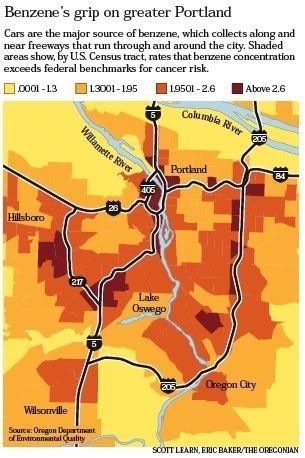Urbanpdx, it sounds like you work downtown. Do you want to be breathing air that contain 200x the safe level of Benzene particle for the next 30 or however many years you will work there?
Part of the article is below, I highlighted the 200x part.

From the Oregonian
Sunday, October 29, 2006
MICHAEL MILSTEIN
On sunny days, families picnic in Tom McCall Waterfront Park, joggers trot by and teenagers chat on cell phones.
You wouldn't know it from the crisp view of a shining Mount Hood, but they're all breathing a soup of toxic air. It's especially full of an invisible but dangerous offender: benzene, spewed from tailpipes of cars on highways ringing the city.
Benzene, a potent chemical that causes cancer and blood disorders, is not unusual in major cities with lots of vehicles. But in Portland, it's worse.
That's because the gasoline we put in our cars, pickups and SUVs is dirtier.
It holds nearly twice as much benzene as the national average and three times as much as gasoline in California, where strict limits make its gasoline the cleanest. Parts of Portland last year recorded benzene levels about as high as the Bronx borough of New York City -- in some neighborhoods many times above levels considered healthy for long-term exposure.
The reason? The federal government requires cleaner gasoline elsewhere -- it makes no such requirement in the Northwest because our skies are considered too clean to trigger regulation. So vehicles in Oregon and Washington, fueled by gasoline made from benzene-rich Alaskan oil, vent about 50 percent more toxic compounds into the air per mile than cars in East Coast and Southern states, data from the U.S. Environmental Protection Agency show.
The skies above humming freeways such as Interstate 5, I-84 and I-405 flow with hidden rivers of these chemicals. Those rivers surge into Portland's urban core, filling downtown, residential neighborhoods and industrial zones like soup in a bowl.
Although the EPA now proposes new rules to reduce benzene in gasoline nationally, it would allow gasoline here to remain the dirtiest in the country and pre-empt Oregon from adopting tougher limits of its own -- because states usually cannot override a federal rule.
State and local air quality agencies are fighting the approach, saying it leaves people here at unacceptably high risk.
Soaring cancer risks
Assessing the risk is tricky. The more benzene in gasoline, the more ends up in the air. Although the risk of developing cancer from a lifetime of breathing benzene remains slim in Multnomah County -- about 26 in a million, far less than the risk from smoking -- it's more than twice the national average, according to federal data.
"The higher the benzene, the worse off you are," said Dave Nordberg, a transportation specialist with the Oregon Department of Environmental Quality.
For people in parts of the city laden with toxic air, however, the risk runs higher. A new analysis by the DEQ, which examined the way bad air swirls through the city, shows benzene concentrations in parts of downtown and the Pearl District at more than 200 times levels considered safe for people breathing it throughout their lives.
etc....
Read the rest of the article at
http://www.oregonlive.com/news/orego...l=7&thispage=1



